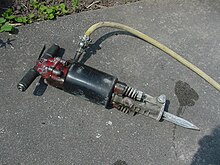This article needs additional citations for verification. (December 2008) |

A jackhammer (pneumatic drill or demolition hammer in British English) is a pneumatic or electro-mechanical tool that combines a hammer directly with a chisel. It was invented by William McReavy, who then sold the patent to Charles Brady King.[1] Hand-held jackhammers are generally powered by compressed air, but some are also powered by electric motors. Larger jackhammers, such as rig-mounted hammers used on construction machinery, are usually hydraulically powered. These tools are typically used to break up rock, pavement, and concrete.
A jackhammer operates by driving an internal hammer up and down. The hammer is first driven down to strike the chisel and then back up to return the hammer to the original position to repeat the cycle. The effectiveness of the jackhammer is dependent on how much force is applied to the tool. It is generally used like a hammer to break the hard surface or rock in construction works and it is not considered under earth-moving equipment, along with its accessories (i.e., pusher leg, lubricator).[2]
- ^ US patent 550324 Steam or Pneumatic Engine
- ^ "POWER TOOL TYPES AND APPLICATIONS - Gibadi". gibadicom. Retrieved 2023-12-27.